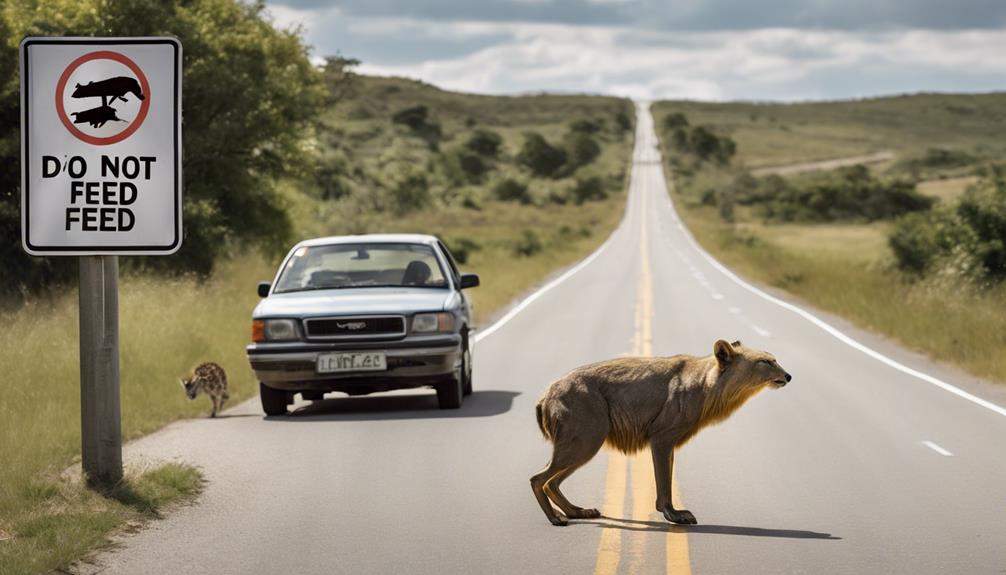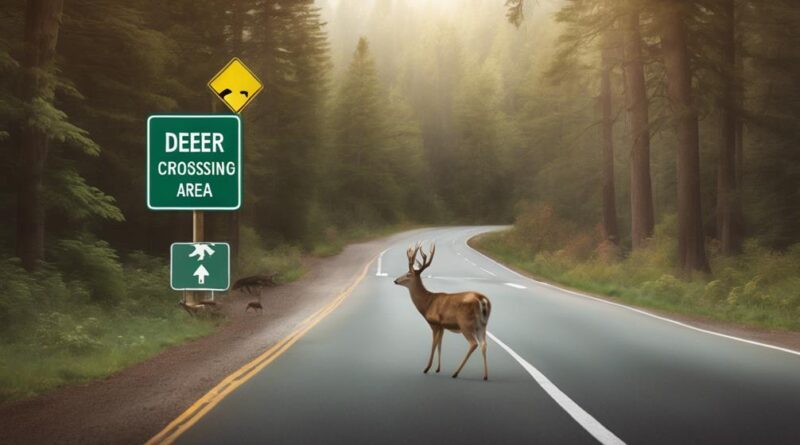What Should You Do During Wildlife Road Encounters?
When faced with wildlife road encounters, you might wonder if there's a best course of action to take. Remember, your safety and the well-being of the animals are equally important.
But what exactly should you do in these situations? It's not just about driving past them; there are crucial steps to follow that can make a significant difference.
Stay Calm and Slow Down
When encountering wildlife on the road, remember to stay calm and slow down immediately. Wildlife behavior can be unpredictable, so it's crucial to prioritize road safety for both yourself and the animals. By remaining composed and reducing your speed, you give yourself more time to react to any sudden movements from the wildlife.
Wildlife behavior varies depending on the species and the situation. Some animals may freeze in the middle of the road out of fear, while others might dart across quickly. This unpredictability underscores the importance of staying calm and slowing down to be prepared for any scenario. Remember, sudden movements or loud noises can startle wildlife and cause them to act erratically.
Road safety is paramount when encountering wildlife. Lowering your speed not only increases your reaction time but also reduces the impact if a collision does occur. By staying calm, you can assess the situation more effectively and make the best decision to avoid harm to yourself, passengers, and the animals.
Be Vigilant and Observant
Stay alert and attentive to your surroundings to effectively navigate wildlife encounters on the road. When faced with unexpected wildlife encounters, it's crucial to be vigilant and observant at all times. Here are some key points to keep in mind:
- Stay alert and avoid distractions: Keep your eyes on the road and avoid distractions such as using your phone or adjusting the radio. By staying focused, you can spot wildlife from a distance and react promptly, reducing the risk of accidents.
- Observe surroundings: Pay close attention to the environment around you. Look for signs of movement, such as rustling bushes or crossing animals. Being observant can help you anticipate wildlife presence and take necessary precautions.
- Anticipate behavior: Different animals exhibit varying behaviors on the road. Some may freeze in the middle of the road, while others might dart across quickly. By anticipating possible behaviors, you can better predict their movements and adjust your driving accordingly to avoid collisions.
Give Animals the Right of Way
How can you prioritize animals' safety on the road? When encountering wildlife on the road, it's crucial to give animals the right of way. To ensure their safety and prevent unnecessary harm, remember to respect boundaries and stay patient.
Respecting boundaries is essential when dealing with wildlife on the road. Animals may have specific paths or areas they're trying to reach, and by giving them space and time to move, you can avoid stressing them or causing them to panic. If you encounter animals like deer, bears, or smaller creatures crossing the road, slow down and maintain a safe distance to allow them to pass without feeling threatened.
Staying patient is key in wildlife road encounters. Animals may not move as quickly as vehicles, and it's important to remember that they've just as much right to be on the road as you do. Avoid honking your horn or revving the engine, as this could startle the animals and lead to unpredictable behavior. Instead, practice patience and wait for them to safely cross before continuing on your way.
Avoid Sudden Movements
To ensure your safety and that of the wildlife on the road, maintaining a steady and predictable pace is crucial to avoid sudden movements that could startle or endanger animals.
When encountering wildlife on the road, remember the following:
- Stay still: If you spot an animal on the road or near it, the best course of action is to stay as still as possible. Sudden movements can be perceived as a threat, potentially causing the animal to react defensively or unpredictably.
- Remain calm: While it may be alarming to come across wildlife unexpectedly, keeping a calm demeanor is essential. Panicking or making sudden gestures can agitate the animals and increase the risk of a dangerous encounter.
- Proceed with caution: If you need to navigate past wildlife on the road, do so slowly and cautiously. Abrupt acceleration or deceleration can startle the animals, leading to unintended consequences. By maintaining a composed and deliberate approach, you can minimize the chances of provoking a negative reaction from the wildlife.
Use Your Horn Sparingly
When encountering wildlife on the road, limit your use of the horn to avoid startling or agitating the animals unnecessarily. Wildlife behavior can be unpredictable, and loud noises like honking can startle them, causing them to panic and potentially dart into the path of your vehicle. It's crucial to maintain driver awareness and be prepared to react calmly in these situations.
Animals may react differently to the sound of a horn. Some may freeze in place, while others might become frightened and run erratically. By using your horn sparingly, you reduce the risk of provoking a dangerous response from the wildlife. Instead, slow down and proceed with caution when you notice animals near the road. This approach not only keeps you safe but also respects the natural habitat of the animals sharing the road with you.
Keep a Safe Distance
Maintain a safe distance between your vehicle and wildlife on the road to prevent dangerous encounters. When encountering wildlife on the road, it's crucial to remember that animals can behave unpredictably, and caution is key to ensuring everyone's safety.
Here are some essential tips to keep a safe distance and handle wildlife encounters responsibly:
- Understand Wildlife Behavior: Wildlife behavior can be influenced by various factors such as the time of day, season, and the presence of young ones. Approach slowly and observe their movements to determine their intentions. Avoid sudden movements or loud noises that may startle them.
- Practice Safe Driving: Keep a safe distance from animals on the road by reducing your speed and increasing your following distance. This allows you more time to react if an animal suddenly crosses your path. Stay alert and scan the sides of the road for any signs of wildlife.
- Avoid Approaching Too Closely: It's essential to give wildlife ample space and respect their territory. Don't attempt to get too close for pictures or a better look. Getting too close can stress the animal and increase the risk of an aggressive reaction.
Do Not Feed Wildlife

Resist the urge to feed wildlife along roadsides, as it can disrupt their natural behaviors and pose risks to both animals and humans. Wildlife protection is crucial, and feeding wild animals can have detrimental effects on their health and safety. When animals become accustomed to being fed by humans, they may lose their natural foraging instincts, leading to dependency on handouts. This can disrupt their hunting or foraging patterns, causing imbalances in local ecosystems.
Additionally, feeding wildlife can alter their diets, leading to malnutrition or health issues. Foods provided by humans may lack essential nutrients or contain harmful substances, putting animals at risk. Furthermore, feeding wildlife can attract them to roadsides, increasing the chances of vehicle collisions that harm both animals and humans. This is where environmental awareness plays a vital role.
Report Injured Animals
Curious about what steps to take if you encounter an injured animal on the roadside? It's crucial to act swiftly and responsibly to ensure the well-being of the animal and contribute to wildlife conservation efforts. Here's what you should do:
- Assess the Situation: When you come across an injured animal on the roadside, first ensure your safety and that of others around you. Approach the animal cautiously, keeping a safe distance to avoid causing further distress. Take note of the animal's condition and any visible injuries before proceeding.
- Contact the Authorities: Once you have assessed the situation, it's essential to report the injured animal to the appropriate authorities. Notify local wildlife services, animal control, or a wildlife rehabilitation center about the animal's location and condition. Providing accurate information can help experts provide timely assistance and medical care.
- Promote Animal Welfare: Reporting injured animals not only aids in their individual well-being but also contributes to broader animal welfare and wildlife conservation initiatives. By taking action and reporting these incidents, you play a vital role in ensuring that injured animals receive the care they need and raising awareness about the importance of protecting wildlife.
Frequently Asked Questions
What Kind of Wildlife Encounters Are Most Common on the Road?
Encountering wildlife on the road can be unpredictable. Common wildlife encounters may include deer, squirrels, birds, and even small mammals. Understanding wildlife behavior is crucial for road safety.
Animals may dart across the road unexpectedly, increasing the risk of accidents. Being alert and cautious while driving is essential to avoid collisions with wildlife.
How Can I Determine if an Animal Is Injured or in Distress?
To determine if an animal is injured or in distress, observe its behavior closely. Look for signs like limping, difficulty breathing, or unusual movements. Use identification techniques like noting the species and behavior patterns.
If you suspect an animal needs help, take emergency response steps. Provide first aid if safe and necessary. Remember, your actions can make a difference in helping wildlife in need.
Are There Specific Times of Day or Seasons When Wildlife Encounters Are More Likely?
Nighttime dangers can increase the likelihood of wildlife encounters on roads. Seasonal patterns also play a role, with certain times of the year seeing peak activity.
Be cautious during morning hours as risks may be higher then. Stay alert and watch for wildlife crossing, especially during these times. It's important to be aware of these factors to improve your safety when driving.
What Should I Do if I Encounter a Large Animal, Such as a Bear or Moose, on the Road?
If you encounter a large animal like a bear or moose on the road, stay calm and back away slowly. Avoid sudden movements and loud noises.
Give the animal plenty of space to move away without feeling threatened. Remember, your safety is the priority, so don't attempt to approach or feed the animal.
Always respect wildlife and their natural habitat to prevent any dangerous situations.
How Can I Safely Navigate Around Wildlife Without Putting Myself or the Animal in Danger?
When encountering wildlife on the road, be cautious and considerate. Understand wildlife behavior and take safety precautions.
Practice defensive driving and be aware of animal behavior. Slow down, honk your horn gently, and give them space to move away. Avoid sudden movements that could startle the animal.
Stay alert and prepared to react calmly to keep yourself and the wildlife safe during road encounters.
Conclusion
Remember, when encountering wildlife on the road, it's important to stay calm, slow down, and be vigilant. Give animals the right of way, avoid sudden movements, and keep a safe distance.
Use your horn sparingly and never feed wildlife. If you come across an injured animal, report it to the appropriate authorities.
By following these simple guidelines, you can help keep both yourself and the animals safe during road encounters.
